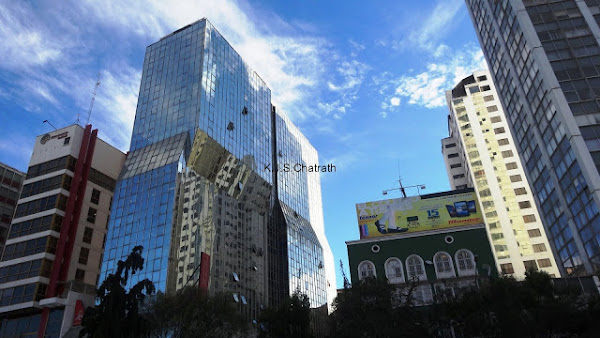'Reverse Clock atop Bolivia's Parliament building' - by K.J.S.Chatrath
I visited Bolivia including its administrative capital- La Paz in 2014 and fell in love with the country and the city. Here one sees tradition and modernity side by side. La Paz, in Bolivia, is the highest administrative capital in the world, located in the Andes’ Altiplano plateau at 3,640m or about 12,000 feet above sea level. It stretches to El Alto city in the highlands, with snow-capped, 6,438m-high Mt. Illimani as its backdrop. The city's dramatic setting can be taken in during rides on Mi Teleférico, the aerial cable car system which the Bolivians pride in.
The Plaza Murillo is the central plaza of La Paz and the open space most connected to the political life of Bolivia. Prominent buildings on the plaza include the Presidential Palace, National Congress of Bolivia, and the Cathedral of La Paz. It is located in the old town, or Casco Viejo, of the city.
3
This Plaza was originally named the Plaza Mayor (Greatest/Main Plaza) after its construction. It was Later, during the colonial period, it was known as the Plaza de Armas (the Parade Ground). Following independence, it was renamed the July 16 Plaza (Plaza 16 de Julio) on February 3, 1902, in honor of Pedro Murillo, captured and hung by Spanish troops in January 1810. An interesting sight in the Plaza is the clock in the spire of the National Congress of Bolivia. This clock runs anti clockwise!
4
This analogue clock on the top La Paz's House of Congress underwent an unusual change in 2014. It was reconfigured to run backwards so that its hands turn counterclockwise.
5
In fact the very concept of 'clockwise' and anti-clock wise was challenged. ‘Who says that the clock always has to turn one way? Bolivia’s Foreign Minister David Choquehuanca proudly declared the unorthodox new mechanism to be ‘The Clock of the South’. Why do we always have to obey? Why can’t we be creative?’ Mr. Choquehuanca asked. He saw the backwards clock as a way of paying homage to the nation’s indigenous heritage. It is said that the indigenous Aymara and Quechua peoples have a traditional belief system that the past lies ahead while the future is behind us.
6
Going back into history, the modern analogue clock is believed to have evolved out of the idea of sundial, the old timekeeping device going back to the Romans over 2,000 years ago. In the Northern Hemisphere, the shadow from a sundial naturally moves in a clockwise direction. Down in South America, however, the opposite is true, which partly inspired the unusual change of direction in The Clock of the South.
one may recollect Alice in Wonderland's 'A Mad Tea-Party' in Chapter VII of this book. There is an interesting conversation about a clock that moves in reverse, stops and freezes time on demand etc.(https://www.cs.cmu.edu/~rgs/alice-VII.html). (). Taking a cue from that some American companies are marketing clocks that move in the reverse direction.
(Text with liberal inputs from internet, Wikipedia and 'Why This Clock in La Paz Runs Backwards’ by Harry Stewart. https://theculturetrip.com/south-america/bolivia/articles/why-this-clock-in-la-paz-runs-backwards/)










Comments
Post a Comment